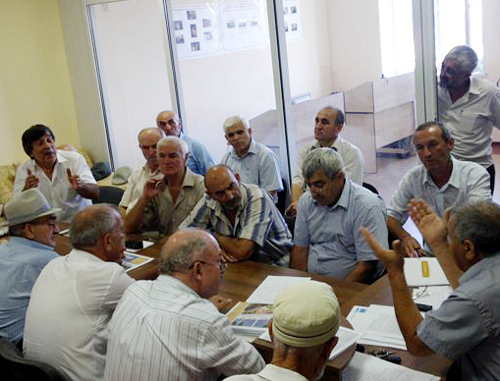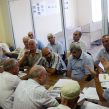
Moscow Unable to Institute Vital Reforms in Dagestan as Ethnic Tensions Rise
Publication: Eurasia Daily Monitor Volume: 9 Issue: 136
By:

On July 7, in the capital of Dagestan, Makhachkala, the Council of Kumyk Elders gathered for an extraordinary meeting, which focused on issues of land redistribution in the republic. In order to make their voice heard, the Kumyks asked President Vladimir Putin to include an ethnic Kumyk on the recently created presidential Nationalities Council. Earlier, on June 1, the president of Dagestan, Magomedsalam Magomedov, cited land privatization as one of his government’s priorities. This alarmed ethnic Kumyks in Dagestan, who fear losing their position to other ethnicities in the republic. The head of the Council of Kumyk Elders, Absalitdin Murzaev, told the Kavkazsky Uzel (Caucasian Knot) website: “In the ten towns of Dagestan that are located on Kumyk lands, there is not even one mayor of Kumyk nationality, while Kumyks themselves have become a minority in their historical lands. Under these circumstances, the introduction of private ownership of land portends losing the remainder of our people’s historical territory” (https://dagestan.kavkaz-uzel.ru/articles/209587/).
Ethnic Kumyks are a Turkic-speaking people who reside chiefly in Dagestan. The Kumyks are the third largest ethnicity in Dagestan after the Avars and Dargins, with their total numbers topping 430,000 – 15 percent of Dagestan’s population. Kumyks are also concentrated in North Ossetia’s Mozdok district, where an estimated 16,000 reside. Over 12,000 ethnic Kumyks also live in Chechnya (2010 Russian census, www.gks.ru). The Kumyks traditionally controlled a large part of the Dagestani plains, but as the process of relocating Dagestanis from the republic’s mountainous areas to its lowlands accelerated, the Kumyks found themselves increasingly in the minority.
Kumyk protests are not new in Dagestan: at a large rally in 2008, Kumyk activists adopted a lengthy and harshly-worded resolution (https://kumukia.ru/article-9400). In 2010, another large Kumyk rally accused Moscow of inaction. “The Kumyk people, whose role in the creation of the republic [of Dagestan] was indispensable, have not been allowed to rule Dagestan for over 80 years now, although the bulk of the political and economic life of the republic takes place on Kumyk land,” the resolution stated. “The majority of the republican population also lives on Kumyk territory, while the Kumyks comprise only 20 percent of the population of these areas” (https://kumukia.ru/article-9495.html).
The replacement of an ethnic Kumyk with an ethnic Avar as the head of the Dagestani government triggered the 2010 protest. The informal rules of Dagestani politics ensure that each of the top government positions is reserved for a certain ethnicity. So the positions of head of the republic, parliamentary speaker and the head of the government have normally been distributed among the three main ethnicities – the Avars, Dargins and Kumyks. The Kumyks eventually received “compensation” for losing the head of the government position when Magomed-Sultan Magomedov, an ethnic Kumyk, became the parliament’s speaker (https://www.rg.ru/2010/03/25/dag.html).
The issue of land ownership is a very sensitive topic in the North Caucasus. The region is not only one of the most densely populated areas of the Russian Federation; it also has the largest proportion of the country’s population living in rural areas and is dependent on agricultural production. Russian economist Irina Starodubovskaya believes land reform in the North Caucasus and the introduction of private ownership of land would help alleviate violent conflicts in the region. The North Caucasus administrations have largely blocked the land reform that was introduced in other parts of the Russian Federation in the 1990s. The division of land into federal, regional and municipal ownership has not been completed. Because of the shaky legal foundation, private ownership of land is not well protected. The end-result of the stalled reforms in the North Caucasus was economic stagnation and the appropriation of the land redistribution processes by the bureaucracy. “In the North Caucasus there is this inherent complexity: we often find ourselves in such a situation where inaction is not feasible, but undertaking something is scary. This is especially evident in the land question. Land reform is about changing the balance of winners and losers in this sphere and every change of such a balance always results in additional conflicts,” Starodubovskaya told Kavkazsky Uzel, citing conflicts in Dagestan (https://www.kavkaz-uzel.ru/articles/206327/).
In May 2012, the situation nearly spiraled into massive clashes in Makhachkala’s suburbs. Each having interests in Makhachkala’s administration, ethnic Kumyks, Laks, Avars and Chechens clashed. And it took the vigorous effort of the informal leaders of these groups to prevent violence. “Bloodshed was miraculously avoided,” one author wrote following the standoff (https://www.ndelo.ru/one_stat.php?id=6945).
It is noteworthy that despite the tensions in Dagestan, the conflicting sides tend to blame Moscow for their problems. A 2008 appeal by the Kumyks to then Russian President Dmitry Medvedev stated: “Our loyalty was misinterpreted by the Russian leadership. It resulted in permissiveness and utter disregard of the Kumyk people’s interests. The authorities started to resolve political, economic, territorial and other issues of all other peoples in the region at the Kumyks’ expense. This has not stopped to this very day! We intentionally do not mention the leadership of the republic and the other peoples of Dagestan, as their fault is secondary, because it was Moscow that took the principal decisions and financially backed them. Therefore, the main and primary responsibility for the current disastrous state of the Kumyk people lies with the Russian authorities!” (https://kumukia.ru/article-9400).
Given the absence of democratic institutions and concentration of power in Moscow, the conflicting sides in Dagestan expect Moscow to resolve their problems. However, even if the Russian authorities wanted to, they would not be able to help much without involving the locals in the decision-making process. At the same time, the exclusion of the people and their genuine representatives from the decision-making process is one of the fundamental aspects of the contemporary Russian state. Thus, potentially devastating conflicts in Dagestan are not simply a manifestation of the effects of lagging economic reform, but rather a consequence of the absence of political reform. Russian authorities and experts willingly discuss the clannishness, corruption and need for economic reforms in the North Caucasus. Yet they shy away from recognizing that because of the undemocratic political order imposed on the region by Moscow, the locals have no instruments to advance the necessary reforms. While the Russian leadership lacks the power to impose reforms on the regional governments that make up the North Caucasus.




